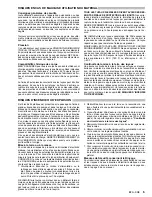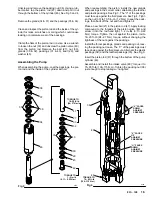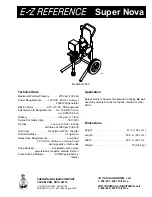
19
PRESSURE CONTROL CALIBRATION
USE EXTREME CAUTION WHEN PERFORMING THIS CALIBRATION PROCEDURE to reduce the risk of an
injection injury or other serious bodily injury which can result from component rupture, electric shock, fire, explo-
sion, or moving parts.
This procedure sets the sprayer to 2750 psi (190 bar)
MAXIMUM WORKING PRESSURE.
This procedure must be performed whenever micros-
witch or pressure control assembly is removed and re-
installed or replaced to be sure the sprayer is properly
calibrated.
Improper calibration can cause the sprayer to over-
pressurize and result in component rupture, fire or ex-
plosion. It may also prevent the sprayer from obtaining
the maximum working pressure which would result in
poor sprayer performance.
NEVER try to increase the fluid outlet pressure by per-
forming these calibrations in any other way. Normal
operation of the sprayer at higher pressures could re-
sult in component rupture, fire or explosion. To perform
this adjustment, however, the sprayer pressure must
be
temporarily increased above the normal working
pressure.
Use a new 50 foot (15.2 m) spray hose rated for 3000
psi (210 bar) MAXIMUM WORKING PRESSURE
when performing this procedure. A used, under–rated
hose could develop a high pressure leak or rupture.
WARNING
Service Tools Needed:
D
Items in Fig 11
D
5 gallon pail and water
D
Needle valve, P/N
D
3/8 in. socket wrench
102–715 or 103–067
D
Mineral spirits
Fig 11
0785
TEE, 104–984
FLUID FILLED
PRESSURE
GAUGE, 102–814
NEW 50 FT. , 3000 PSI
FLEXIBLE NYLON
AIRLESS SPRAY
HOSE, 223–541
NIPPLE, 162–453
1.
Relieve pressure. See page 12.
2.
Plumb the pressure control with additional parts as
shown in Fig 11. Connect the needle valve to the
open end of the hose.
NOTE: See Fig 12 for the following procedure.
3.
Remove the cover (79) and plug (123).
4.
Open the needle valve slightly. Turn the pressure
control knob (A) to the minimum setting.
5.
Plug in and turn on the sprayer. Increase the pres-
sure setting just enough to start the sprayer. Prime
the hose and purge all air from the system.
6.
Open the needle valve a little more––enough to allow
the pump to run continuously––and turn the pressure
control knob to maximum. Now, very slowly start to
close the needle valve, but don’t close it all the way.
Observe the pressure at which the pump stalls,
which should be approximately 2750 psi (190 bar).
NOTE: The slower the pressure is raised, the easier it is
to note the exact stall pressure. Closing the
needle valve quickly causes the pressure to rise
too fast which gives a false reading.
If the pressure is lower than 2750 psi (190 bar):
Unplug the sprayer. Relieve pressure. Insert the
socket wrench through the plug hole and untighten
the pressure adjustment nut 1/8 turn or less, then re-
peat steps 5 and 6.
If the pressure is higher than 2750 psi (190 bar):
Unplug the sprayer. Relieve pressure. Insert the
socket wrench through the plug hole and tighten the
pressure adjustment nut 1/8 turn or less and repeat
steps 5 and 6. Repeat this procedure until the proper
stall pressure is obtained.
7.
Now check to see at what pressure the sprayer starts
to run again after it stalls. Plug in the sprayer, turn it
on, close the needle valve, and set the pressure at
maximum. Allow the sprayer to run until it stalls.
8.
Open the needle valve very slowly while observing
the pressure gauge. Check to see if the pressure
drops to approximately 2350 psi (164 bar) before
starting again.
If the pressure is not
2350 psi (164 bar):
Shut off and unplug the sprayer, but do not relieve
pressure. Turn the differential wheel (D) just one
notch and repeat Steps 5 and 6. Check the pressure
drop again and repeat if necessary.
NOTE: Always recheck the stall pressure (steps 5, 6) if
the differential wheel was adjusted.
9.
Follow the Pressure Relief Procedure Warning on
page 12. Flush the water out with mineral spirits. Re-
lieve pressure again. Install the plug (123) and cover
(79). Remove the test equipment.
Fig 21
ON/OFF SWITCH
A
B
D
TIGHTEN
C
0750








































